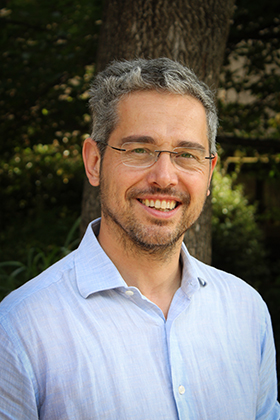Francesco Prada, MD, joined the Foundation as a Merkin Scholar in July 2017. The Foundation’s first clinical fellow, Prada began practicing neurosurgery in 2000 and to date, he has performed more than 500 ultrasound-guided neurosurgical procedures. After relocating from the Istituto Neurologico Carlo Besta in Milan, Italy, for the original 12-month appointment, Francesco has agreed to stay another year as the Foundation’s Brain Program Director. Read more about his work thus far and the future projects he has planned.

Tell us about your research over the past year.
We completed the first part of a preclinical study on sonodynamic therapy to tackle glioblastoma, which is a type of diffuse brain tumor with a very poor prognosis. Our aim is to use focused ultrasound to activate substances that are known to accumulate within the tumor and are normally used for intraoperative visualization of the tumor for surgical guidance (5-ala/fluorescein) to induce cell death in a small animal glioma model. We plan to start testing the technique in a larger preclinical model soon to assess safety.
As a clinician, I worked closely with colleagues at the University of Virginia on a number of projects:
My mentor is Dr. Jeffrey Elias, a neurosurgeon at UVA, and I am closely following his focused ultrasound treatments for various applications and his patient selection method. Through this experience, I participated in writing a report regarding the adoption and reimbursement of this technique, together with colleagues from the C. Besta Institute in Milan. The paper has now been approved by the regulatory body of the Italian Health System.
Together with UVA neurosurgeon Yashar Kalani, I also obtained approval from UVA’s Internal Review Board (IRB) to study the clinical use of microbubbles in an intraoperative setting. This, along with data from my previous studies conducted in Italy at the Fondazione IRCCS C. Besta of Milan, will help in creating a chart of microbubble distribution in the brain, optimizing focused ultrasound treatments.
I have also been following 57 worldwide brain projects (technical, preclinical and clinical) that are supported by the Foundation and continuously updating a registry with this data.
How long do you plan to continue working for the Foundation?
I was recently named Brain Program Director at the Foundation, and I plan to spend another year here overseeing all projects related to the nervous system while continuing to collaborate with colleagues at UVA on technical, preclinical and clinical projects. After that I would like to continue preclinical and clinical research on focused ultrasound, using it as an adjunct to brain tumor surgery, with the Foundation’s guidance and support.
What future projects are you planning?
I will conclude the second part of the sonodynamic project, which will include sonicating different photo-active substances in large animals to test safety. This will complement the data I’ve already collected in small animal models.
There are also several preclinical projects planned regarding microbubble usage for both brain tumor ablations and blood-brain barrier (BBB) opening.
In the brain tumor project, we aim for direct tumor destruction in an intracranial glioma model, while the BBB study entails using direct microbubble visualization with contrast-enhanced ultrasound to target different brain areas. These two projects will be carried out in animal models, but the ultimate goal is to create a chart of microbubble distribution in space and time in the human brain to optimize treatments in humans. This project will be conducted together with neurosurgeons at UVA.
I also plan to cooperate with Merkin Scholar Frederic Padilla studying brain tumor response to radiosurgery – by combining radiosurgery with focused ultrasound – to treat diffuse brain tumors such as glioblastoma multiforme (GBM).
Of course, I will continue to attend Dr. Elias’s clinical treatments to improve my clinical practice. Along with Dr. Elias and John Snell, PhD, Brain Technical Director at the Foundation, we seek to explore the use of Kranion® (a focused ultrasound simulation software developed by Dr. Snell) as a teaching and simulation tool for brain treatments and to extend it to other centers in the near future.
Share some thoughts on your experience at the Foundation.
I derived my interest for focused ultrasound from my research on intra-operative ultrasound, as I was looking for ultrasound-based therapeutic tools to be merged with diagnostic and image guidance ones.
Meanwhile, we are also installing a focused ultrasound device at my home Institution in Milan. The Foundation seemed the perfect place to learn more about focused ultrasound in its many aspects while also sharing my clinical expertise toward brain applications, especially brain tumors. The environment at the Foundation has been extremely stimulating, and I had the opportunity to contact and cooperate on various projects with leaders in the field while broadening my understanding of how focused ultrasound can impact brain diseases.
